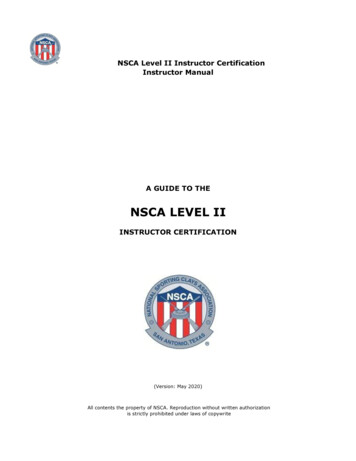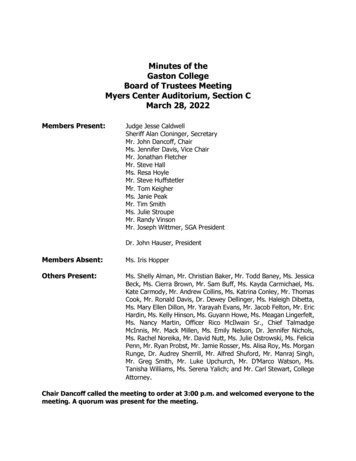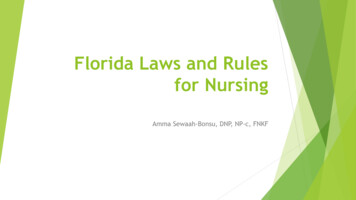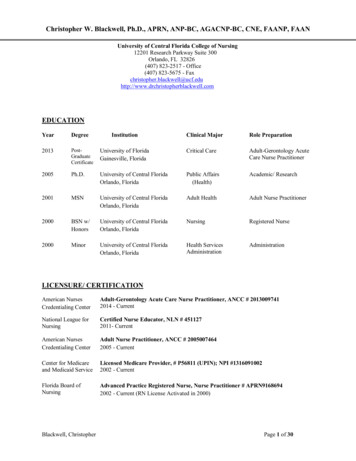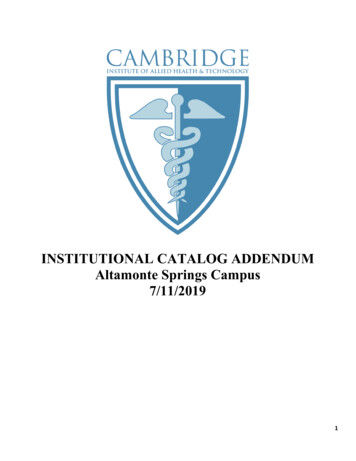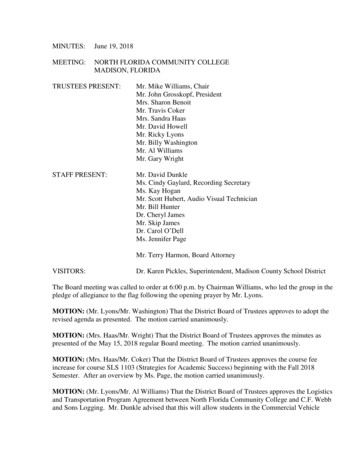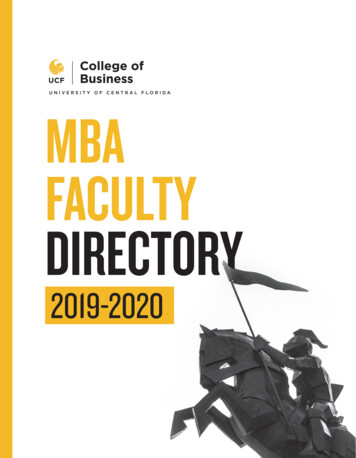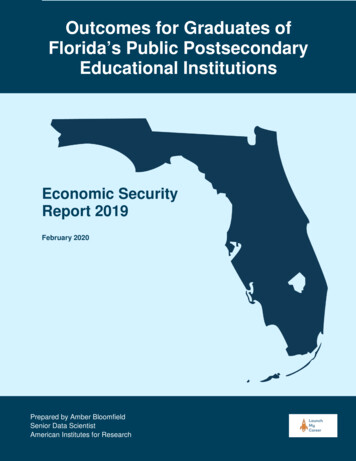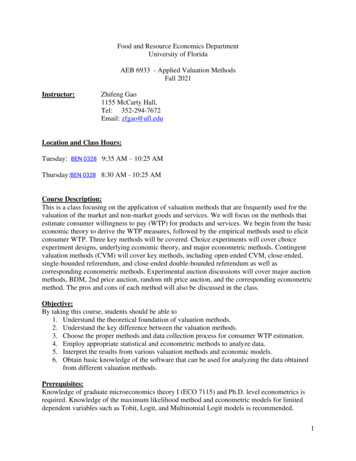
Transcription
Food and Resource Economics DepartmentUniversity of FloridaAEB 6933 - Applied Valuation MethodsFall 2021Instructor:Zhifeng Gao1155 McCarty Hall,Tel: 352-294-7672Email: zfgao@ufl.eduLocation and Class Hours:Tuesday: BEN 0328 9:35 AM – 10:25 AMThursday:BEN 0328 8:30 AM - 10:25 AMCourse Description:This is a class focusing on the application of valuation methods that are frequently used for thevaluation of the market and non-market goods and services. We will focus on the methods thatestimate consumer willingness to pay (WTP) for products and services. We begin from the basiceconomic theory to derive the WTP measures, followed by the empirical methods used to elicitconsumer WTP. Three key methods will be covered. Choice experiments will cover choiceexperiment designs, underlying economic theory, and major econometric methods. Contingentvaluation methods (CVM) will cover key methods, including open-ended CVM, close-ended,single-bounded referendum, and close-ended double-bounded referendum as well ascorresponding econometric methods. Experimental auction discussions will cover major auctionmethods, BDM, 2nd price auction, random nth price auction, and the corresponding econometricmethod. The pros and cons of each method will also be discussed in the class.Objective:By taking this course, students should be able to1. Understand the theoretical foundation of valuation methods.2. Understand the key difference between the valuation methods.3. Choose the proper methods and data collection process for consumer WTP estimation.4. Employ appropriate statistical and econometric methods to analyze data.5. Interpret the results from various valuation methods and economic models.6. Obtain basic knowledge of the software that can be used for analyzing the data obtainedfrom different valuation methods.Prerequisites:Knowledge of graduate microeconomics theory I (ECO 7115) and Ph.D. level econometrics isrequired. Knowledge of the maximum likelihood method and econometric models for limiteddependent variables such as Tobit, Logit, and Multinomial Logit models is recommended.1
Homework and Grading:Homework based on class lectures and reading will be assigned across the semester. Allassignments are due at the beginning of class on the due date. Each student is expected to givethree in-class presentations and one final project.The weights for different components are:HomeworkPresentation 1Presentation 2Presentation 3Final Project20%20%20%20%20%Final grade is based on the weighted average of homework and exams.Course GradeLetter GradeGrade Point90 - 100A4.0087 - 89A3.6784 - 86B 3.3381 - 83B3.0078 - 80B2.6775 - 77C 2.3372 - 74C2.00 72D1.00Presentation 1: Article PresentationEach student would choose a paper from a list provided by the instructor and summarize the keyfinding of the paper. She/he also needs to discuss the pitfalls and potential improvement of thepaper as well as some future research topics related to the paper.Presentation 2: Project Proposal PresentationPresent the research background of their project, including the motivations, the literaturereviews, and the methods.Presentation 3: Final Project PresentationPresent the results, conclusions, implications, limitations, and future research directions of theproject.Applied Valuation Methods Project:The project can be a group project with two or three members per group. The project can be 1) acomplete study (or perhaps pilot) applying the valuation methods discussed in this class; 2) acomprehensive literature review of studies related to valuation methods or estimation ofconsumer preference of market and non-market goods using some statistical method such asMeta-analysis (https://en.wikipedia.org/wiki/Meta-analysis ).2
Suggested Project Structure (adapted from the Authors’ guide of Food Quality and Preference,you can use other structures if you know the journals that you want to publish your paper in)1. Title PageReport titleProject group members and department2. AbstractA brief statement of the motivations, the methods, the main results and key conclusionsof the research project.3. Report bodya. Introduction: motivation of the research project, background, identification, andthe significance of the research problem. Related literature should be discussed,but avoiding a detailed literature survey or a summary of the results.b. Material and methods (i.e. Data collection method; statistical and econometricmodels: Provide sufficient detail to allow the work to be reproduced. Methodsalready published should be indicated by a reference: only relevant modificationsshould be described.c. Theory/calculation: A Theory section should extend, not repeat, the backgroundto the article already dealt with in the Introduction and lay the foundation forfurther work. In contrast, a Calculation section represents a practical developmentfrom a theoretical basis.d. Results: key tests, key tables, and figures, interpretation of the results.e. Discussion: This should explore the significance of the results of the work, notrepeat them. A combined Results and Discussion section is usually onlyappropriate for short communications. Avoid extensive citations and discussion ofpublished literature.f. Conclusions: The main conclusions of the study may be presented in a shortConclusions section, which may stand alone or form a subsection of a Discussionor Results and Discussion section. It should provide the take-home message of theproject, limitation of the project, future direction of the research.Notes:1. One semester may not be enough to complete a full project that requires primary datacollection. If you choose option 1) you can do a pilot data collection with a small samplesize (i.e., collecting data from your classmate or friends). But you still need to analyzeyour data with the models discussed in this class. Hopefully, this process can help youidentify the potential problems in your data collection and analysis so that you can makean improvement if you want to collect a larger sample size in the future to write a fullresearch paper.3
2. It is strongly recommended that you bring your laptop to the class. A laptop is needed tocreate questionnaires online and do data analysis in class.3. Your laptop should have the following software installed: SAS, R, and R Studio. We maydiscuss the use of other software such as Nlogit and Biogeme. But they are not required.4. SAS student license can be purchased from UF. If you don’t want to buy the license, youcan use both online at https://login.apps.ufl.edu/ . Please check more information athttps://info.apps.ufl.edu/ .5. R and R Studio can be obtained https://cran.r-project.org/mirrors.html andhttps://www.rstudio.com/ , respectively.6. Software for reference management: It is recommended that you install Zotero forreference management.Zotero is a free reference management software and browser add-on for referencemanagement. Zotero also integrates with Microsoft Word. You should use it to share thereferences used in your project report so that we can double-check the references. Zoterocan be downloaded at https://www.zotero.org/Another free reference management software is Mendeley. It provide similar function asZotero. You can download it from /A comparison between Zotero and Mendeley is ero-vs-mendeley-comparison/7. The IRB, if you are going to collect data for your project, you need to get IRB approval.Before you apply for IRB, you need to finish the IRB training session rb-02.html8. You can create IRB at http://my.irb.ufl.edu/ . Warning, to log into your account, youmust first log in UF VPN astructure/vpn/). This is required no matter you are on campus or not.9. Qualtrics: Qualtrics is an online platform to create questionnaires for online datacollection. UF has purchased the license, so you can use Qualtrics for free as long as youhave a valid UF ID. You can log into Qualtrics at https://ufl.qualtrics.com/ . If this is thefirst time that you use Qualtrics, you may need to activate your account.Suggested Textbooks (not required):Choice Experiments1. Hensher, D.A., Rose, J.M., Greene, W.H., 2015. Applied Choice Analysis: A Primer.Cambridge University Press. id4
Hensher-dp-1107092647/dp/1107092647/ref dp ob title bk2. Kuhfeld, W.F., 2005. Marketing research methods in SAS. Experimental Design, Choice,Conjoint, and Graphical Techniques. Cary, NC, SAS-Institute 2010.pdf3. Louviere, J.J., Hensher, D.A., Swait, J.D., 2000. Stated Choice Methods: Analysis andApplications. Cambridge University /ref dbs a def rwt hsch vapi tkin p1i04. Train, K.E., 2009. Discrete choice methods with simulation. Cambridge university ntingent Valuation1. Arrow, K., Solow, R., others, 1993. Report of the NOAA panel on contingent valuation.National Oceanic and Atmospheric Administration Washington, 366/mod folder/intro/Arow WTP.pdf2. Hausman, J.A., 2012. Contingent valuation: A critical assessment. Elsevier.3. Mitchell, R.C., Carson, R.T., 2013. Using surveys to value public goods: the contingentvaluation method. Routledge.Experimental Auctions1. Klemperer, P., 2004. Auctions: Theory and Practice. Princeton University Press,Princeton.2. Krishna, V., 2009. Auction Theory. Academic Press.3. Lusk, J.L., Shogren, J.F., 2007. Experimental auctions: Methods and applications ineconomic and marketing research. Cambridge University Press.ReadingsA reading list will be given across the semester. You are expected to read those chapters/paperswith asterisks. You are also responsible for the material in handouts that will be distributed inclass—some supplemental papers and provided for each topic. Students may read unassignedchapters/papers at their discretion.Topic OutlineWeek 1:Introduction to the Course (e.g., Examples, Tools and Software) and TheoreticalFoundation of Valuation Method.Week 2:Choice Experiment DesignWeek 3:Practice of Choice Experiment Design and Manipulation of Choice ExperimentDataWeek 4:Conditional Logit Model and Interpretation of Model ResultsWeek 5:Practics of Manipulation of Choice Experiment Data and Model EstimationWeek 6:Heteroscedastic Extreme Value Model and Mixed Logit Model (MLM) andProject Proposal PresentationWeek 7:Latent Class Model (LCM) and Practice of MLM and LCMWeek 8:Scale Parameters, Scaled Multinomial Logit, Generalized Mixed LogitWeek 9:Willingness to Pay Estimation (WTP), and Model in WTP SpaceWeek 10:Contingent Valuation Method and Experimental Auctions5
Week 11:Week 12:Week 13:Week 14:Week 15:Week 16:Journal Article Presentation 1Journal Article Presentation 2Journal Article Presentation 3Final Project Presentation 1Final Project Presentation 2Final Project Presentation 3Important DatesClasses BeginClasses EndDrop/Add (11:59 pm of last day)Withdrawal with no Fee Liability (11:59 pm of lastday)Reading DayFinal Grades availableHolidays - no classesTentative datesClass Presentation (in class)Final ProjectAugust 23December 8August 23 - 27August 27December 9 - 10December 22September 6: Labor DayOctober 8 - 9: HomecomingNovember 11: Veterans DayNovember 24 - 27: ThanksgivingTBDDecember 18Attendance Policy: Class attendance is expected. Students should inform the instructor ofexpected absences. Excessive unexcused absences will result in negative consequences.Policy On In-Class Cell Phone Use And Text Messaging: Cell phones should be turned off orput on vibrate mode and should not be answered during class periods. Non-emergency, in-classtext messaging is not acceptable.Students Requiring AccommodationsStudents with disabilities who experience learning barriers and would like to request academicaccommodations should connect with the Disability Resource Center. It is important for studentsto share their accommodation letter with their instructor and discuss their access needs, as earlyas possible in the semester.Course EvaluationStudents are expected to provide professional and respectful feedback on the quality ofinstruction in this course by completing course evaluations online via GatorEvals. Guidance onhow to give feedback in a professional and respectful manner is available athttps://gatorevals.aa.ufl.edu/students/. Students are notified when the evaluation period opens,and can complete evaluations through the email they receive from GatorEvals, in their Canvascourse menu under GatorEvals, or via https://ufl.bluera.com/ufl/. Summaries of courseevaluation results are available to students at https://gatorevals.aa.ufl.edu/public-results/.6
In-Class RecordingStudents are allowed to record video or audio of class lectures. However, the purposes for whichthese recordings may be used are strictly controlled.The only allowable purposes are: (1) for personal educational use, (2) in connection with acomplaint to the university, or (3) as evidence in, or in preparation for, a criminal or civilproceeding. All other purposes are prohibited. Specifically, students may not publish recordedlectures without the written consent of the instructor.A “class lecture” is an educational presentation intended to inform or teach enrolled studentsabout a particular subject, including any instructor-led discussions that form part of thepresentation, and delivered by any instructor hired or appointed by the University, or by a guestinstructor, as part of a University of Florida course. A class lecture does not include lab sessions,student presentations, clinical presentations such as patient history, academic exercises involvingsolely student participation, assessments (quizzes, tests, exams), field trips, private conversationsbetween students in the class or between a student and the faculty or lecturer during a classsession.Publication without permission of the instructor is prohibited. To “publish” means to share,transmit, circulate, distribute, or provide access to a recording, regardless of format or medium,to another person (or persons), including but not limited to another student within the same classsection. Additionally, a recording, or transcript of a recording, is considered published if it isposted on or uploaded to, in whole or in part, any media platform, including but not limited tosocial media, book, magazine, newspaper, leaflet, or third party note/tutoring services. A studentwho publishes a recording without written consent may be subject to a civil cause of actioninstituted by a person injured by the publication and/or discipline under UF Regulation 4.040Student Honor Code and Student Conduct Code.University Honesty PolicyUF students are bound by The Honor Pledge: “We, the members of the University of Floridacommunity, pledge to hold ourselves and our peers to the highest standards of honor andintegrity by abiding by the Honor Code. On all work submitted for credit by students at theUniversity of Florida, the following pledge is either required or implied: “On my honor, I haveneither given nor received unauthorized aid in doing this assignment.” The Conduct Codespecifies a number of behaviors that are in violation of this code and the possible sanctions.Click here to read the Conduct Code. If you have any questions or concerns, please consult withthe instructor or TAs in this class.Software UseAll faculty, staff, and students of the University are required and expected to obey the laws andlegal agreements governing software use. Failure to do so can lead to monetary damages and/orcriminal penalties for the individual violator. Because such violations are also against Universitypolicies and rules, disciplinary action will be taken as appropriate. We, the members of theUniversity of Florida community, pledge to uphold ourselves and our peers to the highest7
standards of honesty and integrity.Student PrivacyThere are federal laws protecting your privacy with regards to grades earned in courses and onindividual assignments. For more information, please see the Notification to Students of FERPARights.Campus Resources:Health and WellnessU Matter, We Care: If you or someone you know is in distress, please contact umatter@ufl.edu,352-392-1575, or visit U Matter, We Care website to refer or report a concern and a teammember will reach out to the student in distress.Counseling and Wellness Center: Visit the Counseling and Wellness Center website or call 352392-1575 for information on crisis services as well as non-crisis services.Student Health Care Center: Call 352-392-1161 for 24/7 information to help you find the careyou need, or visit the Student Health Care Center website.University Police Department: Visit UF Police Department website or call 352-392-1111 (or 91-1 for emergencies).UF Health Shands Emergency Room / Trauma Center: For immediate medical care call352-733-0111 or go to the emergency room at 1515 SW Archer Road,Gainesville, FL 32608; Visit the UF Health Emergency Room and Trauma Center website.Academic ResourcesE-learning technical support: Contact the UF Computing Help Desk at 352-392-4357 or via email at helpdesk@ufl.edu.Career Connections Center: Reitz Union Suite 1300, 352-392-1601. Career assistance andcounseling services.Library Support: Various ways to receive assistance with respect to using the libraries or findingresources.Teaching Center: Broward Hall, 352-392-2010 or to make an appointment 352- 392-6420.General study skills and tutoring.Writing Studio: 2215 Turlington Hall, 352-846-1138. Help brainstorming, formatting, andwriting papers.Student Complaints On-Campus: Visit the Student Honor Code and Student Conduct Codewebpage for more information.8
On-Line Students Complaints: View the Distance Learning Student Complaint Process.9
Qualtrics: Qualtrics is an online platform to create questionnaires for online data collection. UF has purchased the license, so you can use Qualtrics for free as long as you



